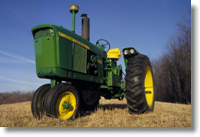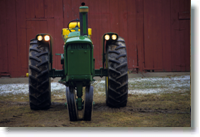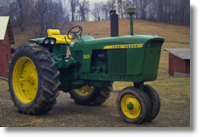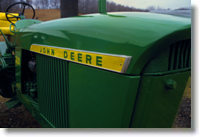| Learning
About This Tractor
I bought the
tractor in January
1999 after
I stumbled across an ad for it in a heavy-equipment sales newspaper,
and
paid $6200 to buy it and have it hauled 280 miles to my dad's
farm.
It's a 1965 model, serial number T111R068427R. The
serial
number
breaks down as follows:
| T |
Tractor |
| 1 |
3020 |
| 1 |
Row
Crop (2 would indicate
Standard, 3
High Crop, 4 Row Crop Utility, and 8 Orchard) |
| 1 |
Gas
engine (2 would be LP,
3 diesel) |
| R |
Syncro-range
transmission
(P would be
Powershift) |
| 068427 |
Chassis
serial number |
| R |
Built
at Waterloo plant |
|
|
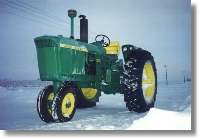
|
The
3020, covered with
ice and waiting to be shipped from the seller's house in Indiana to my
dad's farm. It was mighty cold to be shopping for tractors
that
day,
but the timeless grace and power of this design warmed me right up. See
also: Buying
Tractors in Small
Indiana
Towns |
|
In February 1999, I
spent some time
getting
acquainted with the tractor and fixing various little external odds and
ends. For one hundred dollars and eighteen cents, I replaced
the
spark plugs, steering wheel emblem and spinner knob, light switch knob,
remote cylinder dust plugs, three of the four headlamps, and assorted
indicator
bulbs, bolts, and cotter pins.
| |
Although
the previous
owner rebuilt the
engine and painted the tractor, he kindly left a variety of things for
me to tinker around with. I learned that tractors built in
1965
don't
seem to be any more immune to built-up gunk, stuck bolts, missing
pieces,
and other amusements than older tractors do, and re-learned some other
basic lessons:
- Start
with the obvious. The
headlights
on one fender wouldn't work, so I spent a few hours tracing the wiring
harness and learning about the ways the tractor was put
together.
Couldn't find anything wrong. Finally thought to check the
grounding
in the fender, and of course there wasn't any--newly painted axle
housing,
newly painted fender, equals no electrical bond between them.
A
few
minutes with a screwdriver and wire brush, and the lights
worked.
- If
you need one light bulb
and they cost a
quarter, buy two. The oil pressure lamp worked but the
generator
warning lamp didn't. It was too late in the evening to buy
replacements,
so I spent a while cleaning up and adjusting the position of the
various
indicator lamps, wiring connections, etc. Made the one-hour
round
trip to the John Deere dealer the next day, and bought a replacement
red-tinted
bulb for the generator warning lamp. Put it in and it worked
fine--but
then the #*@! oil pressure lamp was broken. I probably busted
it
the night before by jostling everything around--and by the time I
discovered
it was broken, I didn't have enough time to go get another one.
|
In August 1999
I managed to get
several
hours in with the brushhog, and the tractor loved to work--after an
hour
in the field it ran flawlessly, much more smoothly than in all the
times
of driving around with kids in the wagon or some other no-load kind of
play. And my son and I replaced the burned-out oil-pressure
warning
lamp, which was a project in itself--even on a tractor built in 1965,
metal
housings get rusted together and demand patience and determination as
payment
for allowing themselves to be opened up without being destroyed in the
process.
Syncro-Range
Transmission
Like
the 4020s,
3020s were available with two types of transmissions:
- Powershift,
a
hydraulically-actuated set of
clutches, brakes, and gears in a planetary case (with little "planet"
pinion
gears rotating about central "sun" pinion gears). It provides
eight
forward speeds and four reverse speeds, and can be shifted between any
of them at any time without stopping the tractor.
- Syncro-Range,
a more
conventional transmission
with eight forward speeds and two reverses, grouped into four "shifting
stations": 1st, 3rd, and slow reverse; 2nd, 5th, and fast
reverse;
4th and 7th; and 6th and 8th. The tractor can be shifted
between
any gears in a given station at any time, but must be stopped to shift
between stations.
|
|
My tractor had the
Syncro-Range
transmission.
When I bought it, I noticed that it could sometimes be finicky about
whether
or not it would go into some of the higher gears. In the
second
shifting
station for example, it always went into 2nd but sometimes couldn't
find
5th. In the third station it always went into 4th but
sometimes
couldn't
find 7th. And in the fourth station, I had a heck of time
getting
the shift lever to move over far enough to go into either 6th or
8th.
In August 1999
I got back to the
farm and
adjusted the shifter linkages successfully, or almost succesfully, and
all the gears worked--although then sometimes 3rd gear seemed tricky to
find.
In August
2000, I took the
tractor to the
John Deere dealer to replace leaking oil seals on the load control
shaft,
and to replace the top shaft in the transmission since it still
wouldn't
shift very well. And I realized that I don't get to use the
tractor
very often, and it's a pretty expensive piece of machinery to just let
it sit around and get dusty and in the way... sigh.
| |
Before
trying to adjust
the shifting linkage,
I studied the 3010/3020 service manual to see if I could figure out
what
specifically might be wrong. At the very least, I think I
figured
out how the Syncro-Range transmission itself works, and it's a lot
simpler
than I'd expected. It consists of three parallel, horizontal
shafts,
each with gears on them:
- The
transmission shaft,
which brings power
directly in from the engine crankshaft, through the transmission clutch
on the center of the flywheel. It has three gears on it, one
each
for low range, high range, and reverse.
- The
differential shaft,
which takes power
out of the transmission and passes it on to the differential.
It
has four gears which correspond to the four shifting stations on the
gear
shift lever console: one for 1st, 3rd, or slow reverse
(depending
on which range gear on the transmission shaft is used); one for 2nd,
5th,
or fast reverse; one for 4th or 7th; and one for 6th or 8th.
- The
countershaft, which
has gears on it that
mesh with those on the transmission shaft and those on the differential
shaft, so power is transmitted from one to the other.
The gears on the
countershaft
are all permanently
fixed to the shaft, so the entire thing always rotates as a
unit.
Shifting gears on the tractor doesn't physically change anything on the
countershaft.
The
gears on the
differential shaft are
free to spin independently, except when one of them is engaged by
shifting
the tractor into gear. In between each pair of
gears is a
smaller
drive gear, permanently splined to the differential shaft.
Each
drive
gear is covered by a shifting collar, which is moved horizontally along
the shaft by moving the gearshift lever. The
shifting
collar
has teeth on its inside circumference that mesh with the drive gear,
and
with teeth on the sides of the four transmission gears. When
the
shifting collar is moved against the 1st/3rd gear, for example, its
inner
teeth are meshed with the drive gear and the 1st/3rd gear. In
that
case the 2nd/5th, 4th/7th, and 6th/8th gears are not meshed with a
shifting
collar, so they still spin freely. Changing the position of
the
shifting
collars means physically meshing the teeth in the collar with those on
the transmission gear, so it can only be done when the clutch is in and
the transmission is not in motion.
The
gears on the
transmission shaft are
also free to spin independently except when one of them is engaged by
shifting
the tractor into gear. But unlike the differential shaft, the
transmission
shaft does not use shifting collars with teeth that must be physically
meshed. Instead, it uses "synchronizers", these little
clutch-like
things that are mounted in between the range gears. When you
shift
within a given station, you're not physically meshing any gear
teeth--which
is why it can be done when the tractor is in motion. Instead,
you're
physically moving the synchronizer clutches--which changes which one of
the range gears is actually driven by the transmission shaft and which
ones are disengaged from it. With the shifter lever pushed
forward,
towards the front of the tractor, the forward synchronizer clutch
engages
with the low-range gear, so the tractor is in the lower gear for that
particular
shifting station. The high-range gear and the reverse range
gear
are disengaged and rotate freely.
When you
pull the shifter
lever straight
back towards you, the forward synchronizer simply pulls away from the
low-range
gear and gradually engages with the high-range gear--so the tractor
speeds
up. The teeth of the low range gear are still meshed with the
corresponding
gear on the countershaft, but the low-range gear is no longer
driven--it
just sits there and spins freely while the high-range gear is
driven.
Since there's no meshing or unmeshing of teeth, you can shift back and
forth between low range and high range without stopping the
tractor.
When you
move the shifter
lever over to
the right and then all the way back towards you, the forward
synchronizer
goes to a neutral position, and both the low-range and high-range gears
are disengaged from the transmission shaft. At the same time,
the
reverse synchronizer gets pushed against the reverse range gear, so
then
the tractor is in reverse.
The
service manual is very
well illustrated,
and studying it has been a great education. Call John Deere
Distribution
Services at (800) 522-7448 to order manuals for any John Deere tractor
or piece of equipment.
|
Differences
Between 3010s and 3020s
The 3020
came out
in 1964 as an upgrade of the 3010, which along with the 4010 was one of
the original "New Generation
Tractors"
that John Deere introduced in 1960. Although 3020s
incorporated
some
significant improvements, the majority of features that made the New
Generation
tractors so versatile and capable were in all in place in
1960.
If
you're looking for a tractor to use often with a front loader, a late
3020
with the Powershift transmission and the hydraulic controls on the side
console by the seat would be a great choice. For most other
applications,
there's not much you can do with a 3020 that you can't with a
3010.
Here are some of the major differences between the models (all
information
pertains to row-crop tractors; standards and utility tractors may vary
a little bit):
|
